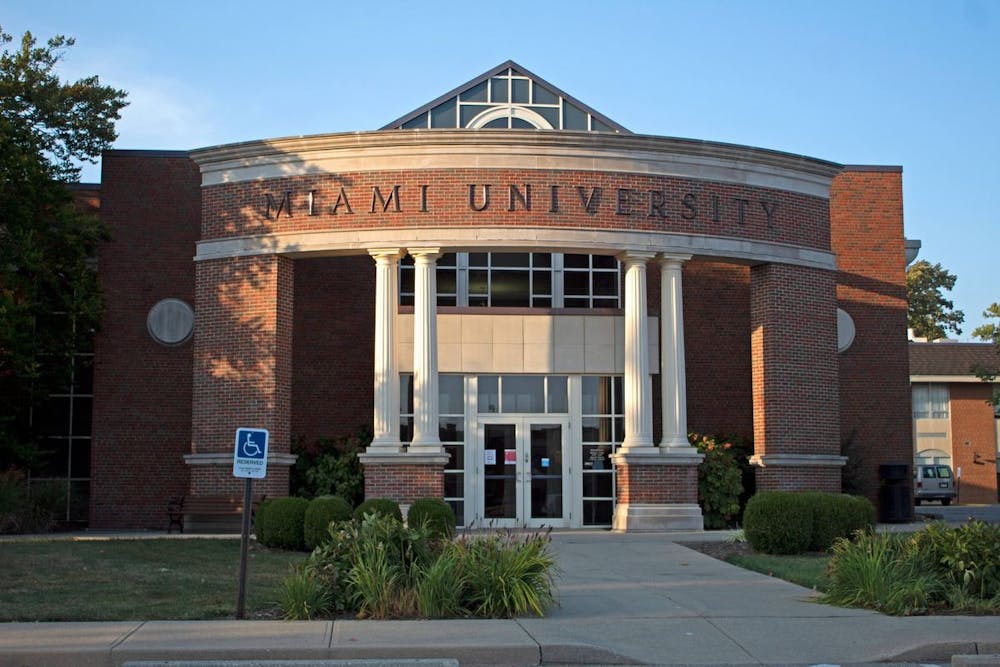Miami University’s acceptance rate increased from roughly 65% to 75% in the last two years, as confirmed by Bethany Perkins, Miami’s director of admissions.
The “original Public Ivy” now has a comparable acceptance rate to universities such as Bowling Green State University (72.3%), Ohio University (78.3%), University of Akron (68.9%) and the University of Cincinnati (73.1%).
David Creamer, vice president for finance and business services and treasurer, said the loss of revenue during the COVID-19 pandemic was a factor in the rising acceptance rate.
“The decision to reduce occupancy has had some impact on revenue generation for the
university, and in doing so, some ways had to be made up for it,” Creamer said.
Brent Shock, vice president for enrollment management and student success, acknowledged the positive financial impact of accepting more students.
“I would say that the financial picture is certainly part of every institution,” Shock said. “I think the bigger reason why that is, is we have a certain number of spots that we want to fill every year.”
Shock said the increase in acceptance rate is not uncommon, and it may continue.
“I would expect that we’ll see an increase in the acceptance rate again, just because of COVID,” Shock said. “Every institution this year accepted more students because they were worried about the effects of COVID.”
Shock said the decline of international student applicants caused the university to admit more domestic students.
“We know, for example, [enrollment rates of] international students are largely based on the policies of the U.S. government, and I think we were watching that carefully to make sure we had a similar number of students,” Shock said. “For example, if there were changes in the U.S. government level, that would prohibit students from entering the country.”
Shock also suggested the effects COVID-19 had on Miami’s admissions might not be realized for a while.
Enjoy what you're reading?
Signup for our newsletter
“I think we don’t know yet what COVID will do for what our final class looks like until October of this year,” Shock said. “That is when we take a census.”
Shock also pointed to the decline in birth rates across the country, which means more schools are competing for fewer and fewer students each year.
“If you look at the U.S. birth rates alone, you’ll see that the birth rate has been pretty much declining since the 70s,” Shock said. “And so what that simply means is that you have the same number of institutions who are vying for a decreasing number of students, and you have to take that into account when you’re thinking about your class for each fall.”
While the acceptance has risen, Creamer said the quality of Miami students has remained consistent.
“The overall acceptance rate did increase for the fall class,” Creamer said. “However, overall quality has remained very comparable to those of the past.”
According to the National Center for Education Statistics, Miami University’s 25th and 75th percentiles in ACT composite scores reportedly range from a 25 to a 30, which is on-par with Miami’s previous academic records.
A 25 to 30 range would still rank Miami higher than all previously mentioned universities, as Bowling Green has a reported ACT range of 19 to 24, Ohio University is reported at 21 to 26, University of Akron at 19 to 25 and the University of Cincinnati’s is at 23 to 29.
“Despite that acceptance rate, Miami has traditionally held at a 28 average ACT for incoming first-year students, and that has not changed,” Shock said. “And what that means is that our students are in the top 85 to 90 percent of test takers nationwide. Our high school GPA has historically been in the 3.75 to 3.8 GPA range, which also would point to the strength of our students.”
Looking ahead, Creamer said he expects acceptance rates to decrease again.
“It’s one of the things we will be looking at, [but] it will probably go down,” Creamer said. “It was an anomaly.”




